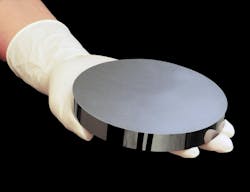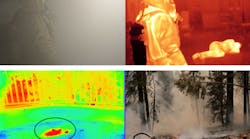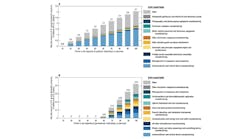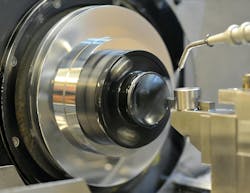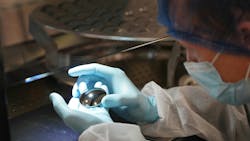Optics industry addresses the germanium issue
Ongoing export restrictions China has in place on germanium and gallium have created quite a stir across the tech space—and for good reason. Thermal optics, light-emitting diodes (LEDs), optical fibers, infrared sensors, semiconductors, and solar panels in their current form all depend on these well-known raw materials.
As of July 2024, ingot prices reached record highs, an increase of 38% since China’s export restrictions took effect in August 2023. Although the feared shortages have yet to surface, taking action to address the potential pitfalls is a real and significant issue, primarily because of China’s global dominance in supplying the material. An unbalanced reliance on strategic materials from a country where we have less-than-favorable relations is never advisable.
Acceptable alternatives?
Proven alternative approaches exist for simple systems that make up many of commercial applications—such as a firefighter’s thermal-imaging camera, handheld cameras used to measure body temperature, or cameras home inspectors use to find to leaks in walls. These are all qualitative rather than quantitative imaging.
Requirements enter the realm of defense applications, which means the refractive index of a material like germanium (4) becomes far more relevant. Other materials like zinc selenide and zinc sulfide hover around 2.5, which is a significant difference. None of those materials have really been able to surface as viable solutions in thermal imaging because of their low refractive index.
Determined to find viable solutions, LightPath Technologies (Orlando, FL) partnered with the U.S. Naval Research Laboratory a few years back and licensed its portfolio of chalcogenide variations, which enable it to offer a much wider range of possibilities than the first chalcogenide optics LightPath created roughly a decade back.
“It is a whole portfolio of materials where they very finely tweaked the parameters to create very unique attributes,” says LightPath CEO Sam Rubin. In addition to increased flexibility, the materials are multispectral in nature, with a spectral coverage ranging from 580 nm to 18 µm.
LightPath’s BlackDiamond BDNL-4 material is one material resulting from the collaboration. BDNL-4 is generating significant interest as a viable alternative to germanium for defense applications, due to its unique property of a negative thermo-optic coefficient.
Multispectral means that the optical system is color-corrected for multiple spectral points for both mid- and long-wave simultaneously. “You would be able to see through dust or haze better than in the long-wave, so having a camera that can do both replaces the need for two cameras, which many systems have today,” Rubin says. “Mid-wave is thermal imaging, so you’ll see the emission from objects, whereas short-wave is reflective imaging, which allows you to see the light reflected off objects. Short-wave can see through clouds or fog—situations that block mid-wave—and it’s especially important in the naval world.”
Related Content
At the Naval Research Lab, the initial motivation was around multispectral imaging—but they ended up creating many more materials that ultimately change the landscape of optical design, while minimalizing the need for germanium.
With a lower refractive index, achieving the same bending of light at the same optical power requires a thicker material—or, in some instances, more than one lens. The higher refractive index of germanium has always been a limiting factor for competing materials. With a new material like LightPath’s BDL-6, its refractive index of 3.2 makes it much closer to germanium.
Coordinate lenses tend to be a softer material, meaning germanium can withstand more extreme conditions. Consider, for instance, the dome that transmits the wavelengths a missile is imaging. “There are some areas where that is not 100% solved,” says Rubin. “If it is a front lens, we can solve it with our diamond-like carbon (DLC) coating, which is almost as hard as a diamond.”
Conquering the coating challenge
Chalcogenides have not always been easy to coat. It’s a material that coating does not adhere to easily, meaning new formulas and approaches are necessary—what worked for germanium will not work here. It doesn’t mean it can’t be done, but there’s a learning curve. Sometimes coating chalcogenides requires the inclusion of adhesion layers to help the optical layers deposit properly.
Coatings are constantly evolving. “It’s a never-ending story,” says Rubin. “When we announce new material availability, we also try to already have a few standard diamond-like coatings ready so people can address application challenges.”
Remaining issues to address
Path to recycling. Recycling plays a key role in most production-based materials. When a manufacturer buys a blank of germanium, they can diamond-turn it, collect all the dust, collect all the scrap, and sell it back to whoever grows germanium ingot for future material.
This is not a reality for chalcogenide today, but a current project to develop the technology to recycle chalcogenide glass is underway, with investments from the Defense Production Act (DPA) title-free industrial base policy and the Defense Logistics Agency (DLA). The solution is a few years out, but should ultimately help with chalcogenide adoption. Recycling is not a must today, but 2-3 years down the road, there will be a lot of scrap material and the economies of scale will benefit from recycling.
The goal is not to fully replace germanium; the goal is to limit our national reliance. “Even when I look at our own multispectral camera—our Mantis camera works from 2 to 12 µm continuously and color-corrects across this whole range—we still need to use one germanium element inside the optical system,” Rubin says. “We can’t get away from it completely, so having some germanium capabilities in the U.S. is important.”
The U.S. Department of Defense (DoD) is pretty good at building reserves and retaining scrap inventory, but reserves do run out and eventually there will not be enough scrap. There’s also some work being done on mining and, more importantly, refining germanium in the U.S. But it’s a nasty process that is very inefficient.
Establishing a comfort level. The raw material or cost of a complete blank can be half as much as a germanium blank—but after processing the blank into a lens, the final lens might cost as much as a germanium. It often boils down to the current lack of maturity with chalcogenide.
The lack of maturity in turning a chalcogenide blank into a finished optic is also an obstacle. Optical designers and engineers have decades of experience using germanium, so it is easy to polish and handle germanium and know how it will behave. The result is a natural hesitancy to jump in and use unfamiliar materials.
LightPath teamed up with the DoD, and specifically with the DLA, to try to solve that manufacturing readiness challenge. “Historically, chalcogenides have had a bad reputation because immature manufacturing techniques led to inconsistent glass batches,” says Rubin. “This caused concern their index would be wildly different between batches.”
Demonstrating uniformity. The goal is to show hundreds of production samples—not from a few measurements, but hundreds of measurements across numerous production batches in many different environments, temperatures, and conditions. “Our objective working with the DLA is to accelerate the acceptance of realistic alternatives,” Rubin says. “Although there is still some noise, there is currently very consistent data to demonstrate the material’s manufacturing readiness at level 9. This is what optical designers need to see.”
Addressing uniformity concerns should reduce any hesitation to adopt the material. Two to three decades ago, chalcogenide lenses were often produced in very small batches to guarantee uniformity or did not have good uniformity at all. However, technologies have changed—and the proof is in the results.
LightPath is also working with academic partners at University of Rochester to validate the uniformity. Currently, interferometric measurements on 5-in.-diameter slices are showing a uniformity within 0.0003, depending on the wavelength. “There’s a vision and drive at the DLA to accelerate the adoption curve of this alternative material to ensure manufacturing readiness,” Rubin says. “The defense industry has such well-defined criteria for technology readiness level (TRL) and manufacturing readiness level (MRL) that we can follow.”
Where we lack the scale is processing it into final lenses. Rubin knows the scope of realistically displacing germanium with new materials is far beyond LightPath’s capacity of lens fabrication alone. The company has capacity to produce 4 million molded lenses a year in the U.S.
To aid adoption, LightPath is making all the materials available as the core material itself. “We can also economically make pregenerated blanks from them, because we’ve patented a unique technology to take the glass and mold it directly into a near net shape,” Rubin says. “It’s a very cost-effective technique that reduces the waste during the process.”
Bottom line
Globally, countries are becoming a bit more controlling of their domestic natural resources, especially when it has strategic (defense) applications. “We need to do the same,” says Rubin. “We have to make sure that the capabilities in the U.S. are developed to the full extent needed to be self-sufficient.”
Addressing the feasibility of materials like chalcogenide can play a meaningful role in moving the needle.
Editor's note: On September 24, 2024, LightPath announced a $3.5 million follow-on order to provide advanced infrared optics for the F-35 combat aircraft program. Justine Murphy covers the announcement in our October 4, 2024 episode of Photonics Hot List.
About the Author
Peter Fretty
Market Leader, Digital Infrastructure
Peter Fretty began his role as the Market Leader, Digital Infrastructure in September 2024. He also serves as Group Editorial Director for Laser Focus World and Vision Systems Design, and previously served as Editor in Chief of Laser Focus World from October 2021 to June 2023. Prior to that, he was Technology Editor for IndustryWeek for two years.
As a highly experienced journalist, he has regularly covered advances in manufacturing, information technology, and software. He has written thousands of feature articles, cover stories, and white papers for an assortment of trade journals, business publications, and consumer magazines.

